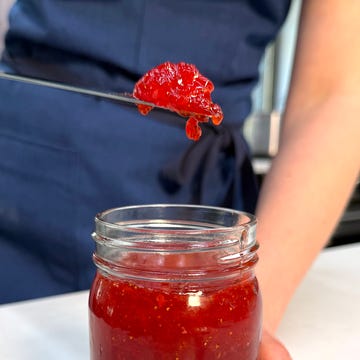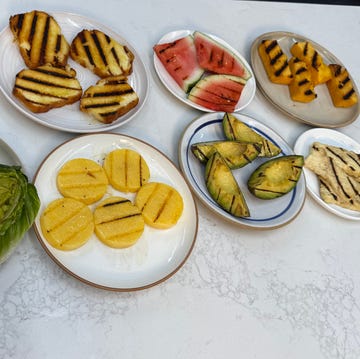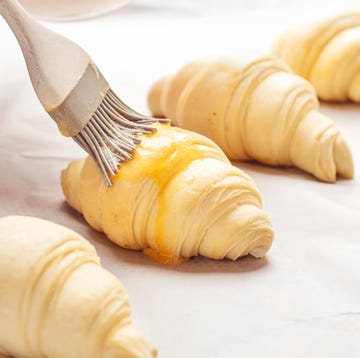There is something charming about berries. Available in colorful, bite-sized packages—like edible decorations—berries are full of complex flavors, textures, and shapes. With over 400 edible varieties from classic supermarket favorites, blueberries and strawberries, to lesser-known options like pineberries or kiwiberries, it’s safe to say that it can be difficult to know exactly how and when to use each berry. This guide takes a look at some of your favorite, or soon-to-be favorite, berries, explaining what they are and how to enjoy them all (berry) season long.
Cranberries
These red, round berries are in season every fall and are found in many Thanksgiving and Christmas classics, and for good reason. Fresh cranberries can be eaten raw, though because they are quite tart, they are mostly enjoyed cooked into baked goods—like our cranberry mimosa breakfast cake or cranberry bread pudding—or cooked down into cranberry sauce, or dried and eaten as a snack on their own or on top of any number of dishes from breakfasts through desserts. They are the classic so tart they are almost bitter berries that bring a pop to any dish they’re added to.
Golden Berries
In the family of tomatillos and ground cherries, golden berries are delightful berries covered in a thin, papery husk. They are a bright, yellow-orange berry that can be found year-round, though they see their peak season in mid-spring through late summer. Golden berries are most often sold fresh, either in or out of their husks, and enjoyed raw for snacking, but also lend well to baking and cooking down to sauces and jams. They are tart and slightly sweet with a tropical flavor somewhat similar to pineapple or mango.
Raspberries
These soft, delicate fruits are in season from late spring to late summer and range from sour to sweet based on their ripeness, though they are generally fairly tart. Raspberries have some floral notes, and this, along with their tartness, makes them great berries to pair with other fruits or to eat fresh on their own. They are great for snacking, baking, and even go great in sauces or dressings, though our favorite way to use them is in desserts like our raspberry cheesecake or our no-bake fruit & granola tart.
Blackberries
These plump, shiny black berries are in season from spring to early fall, with a slightly tart bite and a sweetness that deepens the riper they get. Blackberries have a flavor that is somewhat similar to red grapes, though deeper and juicier. They are wonderful to snack on fresh or sprinkled on top of salads like our blackberry chicken salad or our blackberry-peach salad, or equally as delicious in smoothies and cocktails—like our triple berry smoothie, or Rum Runner, or baked, often alongside warming spices, into a blackberry cobbler or other classic dessert.
Blueberries
Blueberries are in season from spring to late summer and are a favorite of many during these months. Their flavor is not too sweet or tart but balanced somewhere in the middle, with complexity ranging from somewhat citrusy to floral and earthy. Blueberries are favorites for snacking fresh and raw, frozen in smoothies, and baked into everything from muffins to pies and cobblers.
Strawberries
These bright red beauties are favorites year-round, but are really only in season for a short 3 to 4 week period, usually in late spring or early summer. They have a strikingly bright, fresh taste that is actually quite layered. Store-bought strawberries have a sweet flavor and aroma that is somewhat tropical and floral, while wild strawberries, despite being smaller, have deeper, more complex flavors. Strawberries are great for snacking fresh on their own or on top of cereals or salads, as well as cooking down to jam, and baking or freezing into any number of desserts like our strawberry pound cake, strawberry-rhubarb crumble bars, fruit popsicles, or many others.
Pineberries
Pineberries are a hybrid variety of strawberries, similar to white strawberries, that are very similar to classic strawberries. They tend to be smaller than the strawberries you are used to buying in stores, with a similar short growing season from late spring to early summer, and have a sweeter, more tropical flavor that is somewhere between pineapple and strawberry. Pineberries can be substituted for strawberries in any of your favorite recipes, but tend to have slightly less flavor in baked goods than their shiny red cousins, so they perform best in stand-alone snacking.
Kiwiberries
Kiwiberries are adorable mini kiwis that are about the size of grapes and look very similar to gooseberries on the outside and kiwis on the inside. They are very sweet, sweeter even than kiwis, with a tropical, acidic flavor similar to that of their larger cousins. While you can eat the fuzzy skin of kiwis, most people prefer not to, though kiwiberries solve this problem by having smooth skin. Because of their similarities, kiwiberries can be substituted for kiwis in any of your favorite recipes, like our fruit salad.














